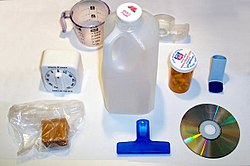Polyetherimide
This article needs additional citations for verification. (September 2014) |
 | |
| Names | |
|---|---|
| IUPAC name benzene-1,3-diamine; 5-[4-[2-[4-[(1,3-dioxo-2-benzofuran-5-yl)oxy]phenyl]propan-2-yl]phenoxy]-2-benzofuran-1,3-dione | |
| Other names PEI, Ultem | |
| Identifiers | |
3D model (JSmol) | |
| ChemSpider | |
| ECHA InfoCard | 100.126.800 |
PubChem CID | |
CompTox Dashboard (EPA) | |
| |
| Properties | |
| (C37H24O6N2)n | |
| Molar mass | Variable |
| Appearance | Amber-to-transparent solid |
| Density | 1.27 g/cm3 |
Except where otherwise noted, data are given for materials in their standard state (at 25 °C [77 °F], 100 kPa). | |
| Polyetherimide | |
|---|---|
| Physical properties | |
| Density (ρ) | 1.27 g/cc |
| Water absorption—over 24 hours | 0.25% |
| Mechanical properties | |
| Tensile strength (σt) | 115 MPa |
| Elongation (ε) at break | 60-80% |
| Izod impact strength | 25-60 J/m |
| Thermal properties | |
| Glass transition temperature (Tg) | 215 C |
| Heat deflection temperature at 0.46 MPa / 66 psi | 210 C |
| Vicat softening point | 220 C |
| Upper working temperature | 375 C |
| Lower working temperature | 365 C |
| Data via Sastri et al., 2014.[1] | |

Polyetherimide (PEI; branded as Ultem[2]) is an amorphous, amber-to-transparent thermoplastic with characteristics similar to the related plastic PEEK. When comparing PEI to PEEK, the former is cheaper but has lower impact strength and a tighter temperature range.[3]
PEI plastics were first introduced into the market by General Electric (GE) in 1982 under the trade name Ultem resulting from the work of J.G. Wirth's research team in the early 1970s.[4][5]
Due to its adhesive properties and chemical stability it became a popular bed material for FFF 3D printers.
Structure
[edit]The molecular formula of the PEI repeating unit is C37H24O6N2 and the molecular weight is 592.61 g/mol.[6] It contains phthalimide and bisphenol A sub-units.
Properties
[edit]The glass transition temperature of PEI is 217 °C (422 °F). Its amorphous density at 25 °C is 1.27 g/cm3(.046 lb/in³). It is prone to stress cracking in chlorinated solvents. Polyetherimide is able to resist high temperatures while maintaining stable electrical properties over a wide range of frequencies. This high strength material offers excellent chemical resistance and ductile properties suitable for various applications, even those involving steam exposure.[7]
Production
[edit]PEIs are manufactured by the imidization reaction of a flexible dianhydride and m-Phenylenediamine.[8][9]
References
[edit]- ^ Sastri, Vinny R. (2014-01-01), Sastri, Vinny R. (ed.), "8 - High-Temperature Engineering Thermoplastics: Polysulfones, Polyimides, Polysulfides, Polyketones, Liquid Crystalline Polymers, and Fluoropolymers", Plastics in Medical Devices (Second Edition), Oxford: William Andrew Publishing, p. 183, doi:10.1016/b978-1-4557-3201-2.00008-2, ISBN 978-1-4557-3201-2, retrieved 2025-05-05
- ^ "Ultem". Curbell Plastics. Retrieved 2 November 2023.
- ^ http://www.mcmaster.com/#ultem/=otzvqt Referenced Oct 7, 2013
- ^ "What Is Polyetherimide (PEI)?". Retrieved 2024-10-15.
- ^ Melton, George H.; Peters, Edward N.; Arisman, Ruth K. (2011-01-01), Kutz, Myer (ed.), "2 - Engineering Thermoplastics", Applied Plastics Engineering Handbook, Plastics Design Library, Oxford: William Andrew Publishing, p. 15, doi:10.1016/b978-1-4377-3514-7.10002-9, ISBN 978-1-4377-3514-7, retrieved 2025-05-05,
Polyetherimide (PEI) was formally announced by GE in 1982. This amorphous polymer with the Ultem trade name resulted from the research work of a team headed by J.G. Wirth in the early 1970s.
- ^ Scott, Chris. "polyetherimide information and properties". www.polymerprocessing.com. Retrieved 2018-04-30.
- ^ "Injection Molding Material Selection Guide". www.abtecinc.com. Retrieved 2018-04-30.
- ^ Sastri, Vinny R. (2014-01-01), Sastri, Vinny R. (ed.), "8 - High-Temperature Engineering Thermoplastics: Polysulfones, Polyimides, Polysulfides, Polyketones, Liquid Crystalline Polymers, and Fluoropolymers", Plastics in Medical Devices (Second Edition), Oxford: William Andrew Publishing, p. 182, doi:10.1016/b978-1-4557-3201-2.00008-2, ISBN 978-1-4557-3201-2, retrieved 2025-05-05,
Polyetherimides (PEIs) are manufactured by the reaction of a flexible anhydride and 1,3-diamino benzene. The anhydride is based on bisphenol A and has both ether and isopropylidene links. It is these two flexible links that provide the flexibility and melt processability to PEI compared to its wholly aromatic analogs.
- ^ Melton, George H.; Peters, Edward N.; Arisman, Ruth K. (2011-01-01), Kutz, Myer (ed.), "2 - Engineering Thermoplastics", Applied Plastics Engineering Handbook, Plastics Design Library, Oxford: William Andrew Publishing, p. 15, doi:10.1016/b978-1-4377-3514-7.10002-9, ISBN 978-1-4377-3514-7, retrieved 2025-05-05,
The early laboratory process involved a costly and difficult synthesis. Further development resulted in a number of breakthroughs that led to a simplified, cost-effective production process. The final step of the process involves the imidization of a diacid anhydride with m-phenylene diamine


 French
French Deutsch
Deutsch
